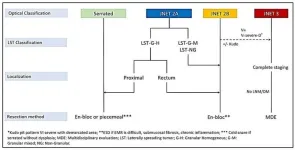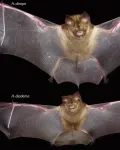(Press-News.org) Researchers who study Earth’s biosphere tend to operate from one of three scientific cultures, each with distinct ways of conducting science, and which have been operating mostly independently from one another, find the authors of a Perspective published in PNAS on April 19, 2024. SFI Professors Christopher Kempes and Geoffrey West, together with External Professor Brian Enquist (University of Arizona) identify and explain the three cultures, and suggest that reconnecting them could help accelerate biosphere science.
The first culture — variance — is what we all participate in when we take part in bird counts or collect bugs or wildflowers. It is naming and observing the details of biology. The second — exactitude — emphasizes models that use ever more data and ever-finer detail and resolution. “Exactitude culture would be the perspective that the best model of the world is a world-sized model,” says Kempes. The third — coarse-grained culture — focuses on generalities, simplifications, and underlying principles. This approach tries to work out the big picture. These cultures exist across science but are currently relatively disconnected in the biosciences.
“Ultimately, good science needs and incorporates all of these cultures,” says West. “And good science — meaning a deep understanding that explains what we know and observe, provides new insights, and makes predictions that can be tested — underlies long-term solutions to big problems. It is critical for informing practitioners and policy-makers in addressing the huge problems of the 21st century. This has become a matter of great urgency for addressing the future of the planet and the sustainability of our entire socio-economic enterprise.”
But there is a lag in developing a predictive science of the biosphere. Critics suggest the cause could be a lack of data, an inadequate number of experiments, or the complex nature of the biosphere. “We suggest it’s more than that,” says Enquist. “In large part, the lag is due to unresolved tension between these three scientific cultures.” And that tension limits how quickly science can progress, how deeply we can understand, and our ability to make predictions. “Synthetic, synergistic, and integrated science — science that can address increasingly more complex problems — occurs when all three cultures are merged,” he says.
The authors point to the theory of evolution as one example. Charles Darwin and Alfred Russel Wallace each started in variance culture but also thought in terms of general principles. They independently developed the (very coarse-grained) theory of evolution. Later, this theory was combined with genetics to produce mathematical theories for population genetics, leading to the Modern Evolutionary Synthesis. That theory, in turn, has been elaborated with models and modern computing by exactitude culture.
Inevitably, tension arises when integrating cultures, but that can be a good thing for science — these tensions reveal assumptions, which leads to a transparent understanding of the key variables and mechanisms driving the system, says Enquist. Integration makes predictions more effective by continually challenging theory with data, and provides a mechanism of iteration. That, in turn, allows scientists to rapidly refine their assumptions and predictions, and guides new data collection.
To move towards integration, the authors suggest the biosphere science community engage more with historians of science, and increase outreach, workshops, undergraduate courses, awards, and funding on transculturalism in science. Finally, scientific journals need to promote papers that transcend not just disciplines, but cultures as well.
As the Modern Evolutionary Synthesis showed, biologists haven’t always been divided by culture and they needn’t be now. By breaking down artificial academic and intellectual barriers, biosphere scientists will open the door to rapid, revolutionary, and urgently needed scientific progress, says Kempes. “All it really takes is people taking interest in the other scientific cultures.”
END
To accelerate biosphere science, reconnect three scientific cultures
2024-04-22
ELSE PRESS RELEASES FROM THIS DATE:
Endoscopic techniques for removing large colorectal polyps
2024-04-22
Colorectal cancer (CRC) is the second most common cancer in the United States. This highlights the importance of early detection and treatment of precancerous lesions like large polyps. Endoscopy offers a minimally invasive approach to removing these polyps, reducing the need for traditional surgery.
This review, published in eGastroenterology, explores advancements in endoscopic resection techniques, specifically Endoscopic Mucosal Resection (EMR) and Endoscopic Submucosal Dissection (ESD).
Complete removal of large polyps (>10 mm) is crucial to prevent progression to CRC. Piecemeal resection during endoscopic procedures can increase the risk ...
Speech Accessibility Project now sharing recordings, data
2024-04-22
The Speech Accessibility Project, which aims to make automatic speech recognition technology more accessible to people with speech differences and disabilities, is now sharing some of its voice recordings and related data with universities, nonprofits and companies.
The project team is accepting signed data use agreements and one-page proposals for 211 recordings of people with Parkinson’s. The download also includes text of the original speech prompts and a transcript of the participants’ responses. A subset includes annotations ...
Scientists in Missouri, Virginia receive pediatric heart transplantation research grants
2024-04-22
DALLAS, April 22, 2024 — Scientific researchers in Missouri and Virginia have been awarded nearly $1.4 million each in grants to study ways to extend the life expectancy and improve the quality of life for children with a transplanted heart. These two research awards mark the latest round of funding for a joint $3 million scientific research initiative between the American Heart Association, celebrating 100 years of lifesaving service as the world’s leading nonprofit organization focused on heart and brain health for all, and Enduring Hearts, the only non-profit organization solely dedicated ...
Same species, different sizes: rare evolution in action spotted in island bats
2024-04-22
A University of Melbourne researcher has spotted a rare evolutionary phenomenon happening rapidly in real time in bats living in the Solomon Islands.
Dr Tyrone Lavery reports in a paper published in Evolution that two groups of leaf-nosed bats with vastly different body sizes that were thought to be separate species are an example of a rare type of parallel evolution. Parallel evolution is when different populations living in similar environments evolve similar features independently.
The smaller bat, Hipposideros diadema, is found across its six main islands and many smaller islands. It is ...
New technology uncovers mechanism affecting generation of new COVID variants
2024-04-22
The SARS-CoV-2 virus that causes COVID has the unsettling ability of often generating variants of itself. Other viruses also mutate, but as SARS-CoV-2 quickly spread throughout the entire human population during the pandemic, killing millions, the virus’ dynamic evolution posed a serious problem: it repeatedly challenged our bodies’ immune response fighting the virus and hindered the process of getting updated vaccines ready.
Understanding the genetic mechanism fueling SARS-CoV-2’s ability to generate variants can go a long way in keeping COVID at bay. In this study published in Nature Microbiology, researchers at Baylor College of Medicine and collaborating institutions developed ...
Planning at multiple scales for healthy corals and communities
2024-04-22
Governments in the Mesoamerican Reef region are exploring the use of nature-based solutions to strengthen coral health and societal benefits for coastal communities. A new study led by Stanford researchers in collaboration with scientists from the World Wildlife Fund, the Healthy Reefs Initiative, and others from the Smart Coasts project quantified the outcomes of different watershed interventions to support coral health at regional versus national scales, and identified target areas that could improve both ecosystem and societal benefits nationally and across the region.
The nature-based approaches evaluated as key ...
U of T researchers map protein network dynamics during cell division
2024-04-22
An international team led by researchers at the University of Toronto has mapped the movement of proteins encoded by the yeast genome throughout its cell cycle. This is the first time that all the proteins of an organism have been tracked across the cell cycle, which required a combination of deep learning and high-throughput microscopy.
The team applied two convolutional neural networks, or algorithms, called DeepLoc and CycleNet, to analyze images of millions of live yeast cells. The result was a comprehensive map identifying where proteins are located and how they move and change in abundance ...
Pressure in the womb may influence facial development
2024-04-22
Physical cues in the womb, and not just genetics, influence the normal development of neural crest cells, the embryonic stem cells that form facial features, finds a new study led by UCL researchers.
The study published in Nature Cell Biology found that an increase in hydrostatic pressure sensed by the embryo can hinder the healthy development of facial features in mouse and frog embryos and in human embryoids (cell structures grown in the lab from human stem cells), suggesting that differences in pressure might affect the risk of facial malformations.
The ...
AI weather forecasts captured Ciaran’s destructive path
2024-04-22
Artificial intelligence (AI) can quickly and accurately predict the path and intensity of major storms, a new study has demonstrated.
The research, based on an analysis of November 2023’s Storm Ciaran, suggests weather forecasts that use machine learning can produce predictions of similar accuracy to traditional forecasts faster, cheaper, and using less computational power.
Published in npj Climate and Atmospheric Science, the University of Reading study highlights the rapid progress and transformative potential of AI in weather prediction.
Professor Andrew Charlton-Perez, ...
Feedback loop that is melting ice shelves in West Antarctica revealed
2024-04-22
Feedback loop that is melting ice shelves in West Antarctica revealed
New research has uncovered a feedback loop that may be accelerating the melting of the floating portions of the West Antarctic Ice Sheet, pushing up global sea levels.
The study, published in Science Advances, sheds new light on the mechanisms driving the melting of ice shelves beneath the surface of the ocean, which have been unclear until now.
The West Antarctic Ice Sheet has been losing mass in recent decades, contributing to global sea level rise. If it were to melt entirely, global sea levels would rise by around five meters.
It’s known that Circumpolar Deep Water (CDW), ...


